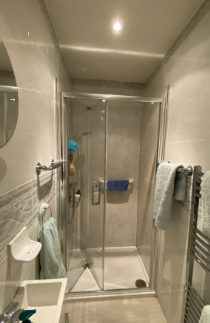What Is A Wet Room?
A wet room is essentially a completely waterproof bathroom designed to allow showering without a conventional shower tray. The floor typically slopes gently towards a central drain, allowing water to drain away, and the walls and floor are specially treated and sealed with a waterproof membrane to prevent leaks and moisture damage.
How a wet room looks
Wet rooms can come in a variety of styles, but they all share some common features. The overall aesthetic of a wet room can vary depending on the design choices. They can be sleek and minimalist, luxurious and spa-like, or modern and industrial.
Unlike a traditional shower stall with a curb, a wet room has an open shower area that is level with the rest of the bathroom floor. The floor slopes gently towards a central drain which is usually covered with a sleek grate. This allows water to drain away efficiently, preventing puddles and moisture build-up.
Since the entire room is exposed to water, wet rooms use waterproof materials like tiles or stones for the walls and floor. As well as this, while not all wet rooms have them, some incorporate a glass screen to help contain water spray and keep the rest of the bathroom dry.
Here is an example of a bathroom before we transformed it into a wet room. Despite the smaller space, it functions perfectly. The free-of-charge 3D design took into account the personal design preferences and mobility requirements of our customer.
This involved removing the existing shower enclosure, floor, mirror and wall cabinet and replacing the floor with our altro wet room flooring. We installed white sparkle wall panelling to all walls, refit the WC, basin and heated towel rail, and positioned the shower seat and grab rails where the customer required them.
Before:

After:

What are the benefits of a wet room in a house
Wet rooms offer several advantages over traditional bathrooms, making them a popular choice for modern homes. Here are some of the key benefits:
- One of the biggest advantages is their accessibility. The absence of curbs and the open floor plan make wet rooms ideal for those with limited mobility, elderly individuals, or wheelchair users. This allows for safe and independent showering.
- Wet rooms can be a great way to maximize space, especially in smaller bathrooms. By eliminating bulky shower units and enclosures, they create a more open feel and can make the bathroom appear larger.
- With waterproof surfaces, wet rooms are generally easier to clean and maintain compared to traditional bathrooms with multiple fixtures and crevices.
- Wet rooms offer a sleek and contemporary aesthetic that can add a touch of luxury to your bathroom.
- In some cases, having a wet room can actually increase the value of your property, especially if it’s designed for accessibility. This is because they are becoming a sought-after feature by potential buyers.

What is a wet room in a house with disabled access
Wet rooms provide several key benefits for people with limited mobility or disabilities, making daily routines like showering safer and more manageable. Here’s how:
- Traditional bathrooms often have curbs or steps leading into the shower or bathtub. These can be a significant obstacle for those with limited mobility or using wheelchairs. Wet rooms have a completely level floor, removing this hazard and allowing for easy roll-in access for wheelchairs or walkers.
- Wet rooms typically offer more open floor space compared to traditional shower stalls. This extra space allows for easier maneuvering with a walker, shower chair, or providing assistance from a caregiver.
- The level floor and grab bars commonly installed in wet rooms provide better stability when showering. This reduces the risk of slips and falls, which are a major concern in bathrooms for people with limited mobility.
- Wet rooms can be easily adapted to incorporate additional safety features like grab bars strategically placed around the shower area, a fold-down shower seat for resting, or a handheld showerhead for easier control while seated.
Overall, wet rooms create a safer and more user-friendly bathroom environment for those with limited mobility or disabilities. They promote independence, reduce the risk of falls, and make showering a more manageable and dignified experience.

What is a wet room bathroom like compared to a normal bathroom?
When comparing a normal bathroom to a wet room, here are some additional things to consider:
- Cost: Installing a wet room can be more expensive than a traditional bathroom due to the waterproofing requirements and specialized installation process.
- Ventilation: Proper ventilation is crucial in a wet room to prevent moisture build-up and mold growth.
- Planning: Since the entire room is exposed to water, careful planning is necessary to ensure proper drainage and avoid water leaks.
If you are interested in accessible bathing but are unsure if a wet room is the right solution for you, perhaps walk-in showers or walk-in baths would suit your needs better?
For example, if stepping over a shower tray is a barrier to comfortable bathing for you, a walk-in shower without a shower tray could be a solution for you.
Walk-in baths with doors that open outwards also support any mobility issues, since you are not having to climb in and out of the bath.




Leave a Reply
Want to join the discussion?Feel free to contribute!